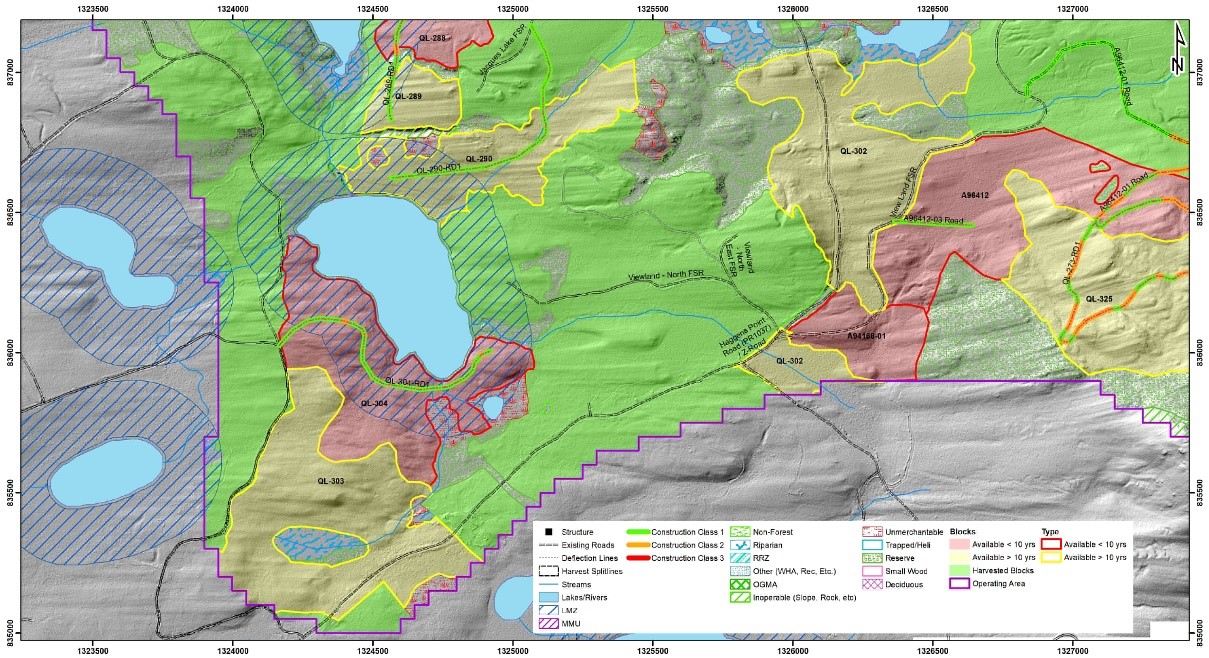Tactical and Spatial Planning (Dry Belt Interior Douglas Fir)
https://storymaps.arcgis.com/stories/17dfe16d5fd543388b8f3af0849ac292
LOCATION
Williams Lake TSA
DATE
2020-2022
DIVISION INVOLVED
Challenge
This tactical and spatial planning project faced several challenges related to the shifting focus of forest management in the Cariboo Chilcotin region. The first challenge is the shift towards harvesting in very different forest types and terrains, which requires new approaches and techniques for forest inventory, planning, and harvesting.
Another challenge is the competing values of the remaining merchantable working forest, which makes it difficult to identify new harvest opportunities that meet the diverse needs of various stakeholders, such as conservationists, Indigenous communities, and the timber industry.
The project also faces strategic challenges, such as the shift towards selective harvest systems in sensitive areas, including Mule Deer Winter Ranges and Caribou Wildlife Habitat Areas, which require careful planning and management to balance ecological and economic considerations.
Furthermore, the project must address the shift away from harvesting in dry, flat, pine forests towards steeper, wetter sites and locations with more public interest, which requires new equipment and techniques to ensure worker safety and minimize environmental impacts.
Finally, the project was designed to significantly increase planning ahead of current needs, which requires a long-term perspective and the ability to anticipate future trends and changes in forest management practices, climate, and other factors.

Solution
Cabin developed LiDAR-based Enhanced Forest Resource Inventory (EFRI) products to inform tactical and silvicultural decision making. Utilizing an aggregated single tree inventory method, Cabin created detailed, LiDAR-derived stand and stock tables “micro-stands” 0.2-5 ha in size.
Utilizing the inventory, we completed landbase netdowns, detailed multi-pass block and road planning, economic analysis and Tactical Development Plan Reports for the area of interest. In order to make this process more efficient and complete the project within the allotted time, Cabin developed ArcGIS tools for completing the landbase netdown and identifying inoperable areas in the LiDAR data. Updated Patch size and seral stage distribution forecasts were completed for the projected 10-year harvest sequence. Tactical plans were subsequently used in a Forest Estate Model, comparing sustainable harvest levels for a range of scenarios and constraints. Cabin provided GIS analyses within detailed specifications in order evaluate the effect of management options on short, mid and long-term timber supply in the Business Area. This information was presented to the client in written report and graphic formats. Cabin provided comprehensive explanation of the implications and assumptions of each scenario during meetings with the client.
Finally, the information provided in the inventory and tactical plans was used to develop and prescribe silvicultural strategies and harvest entries for uneven-aged management and identify stands that were eligible for alternative harvest strategies including single tree selection, shelterwood, commercial thinning and group selection systems.
General Inquiries
Vernon Office
Unit 20A - 100 Kalamalka Lake Rd.
Vernon, BC, V1T 9G1
778-475-3655
Nelson Office
Room #500A - 901 Front St.
Nelson, BC, V1L 4C1
778-463-1045
Kelowna Office
#2-3304 Appaloosa Rd.
Kelowna, BC, V1V 2W5
Nakusp Office
119 Broadway St W
Nakusp, BC V0G 1R0
250-265-3603
